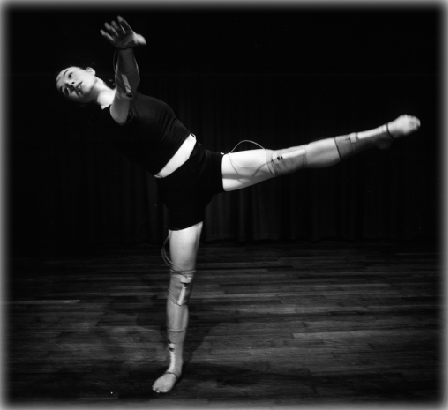1996-1999
The Digital Dance Project was a research project conducted at DIEM. The goal of the project was to create a computer music composition that allows a dancer to directly influence musical processes. A wireless dance interface, the DIEM Digital Dance System, was designed and built. Several seminars, compositions, performances and colloborative projects as well as an article in the Computer Music Journal have resulted.

General Information
Digital Dance was a research project conducted at DIEM involving hardware and software development as well as the creation of a rule-based compositional system. The project sprang from a vision that a dancer’s body movements could control musical processes during a performance. The goal of the project was to create a computer music composition that allows a dancer to directly influence musical processes in a meaningful way.
In November 1995 Jens Jacobsen, an electrical engineer, began working at DIEM in collaboration with DIEM’s director, Wayne Siegel, to research existing interactive dance interfaces and develop a new interface. Advantages and disadvantages of several systems were considered and a new interface system was designed in collaboration with the Aarhus School of Engineering. After years of development and refinement the DIEM Digital Dance System version 2.0 was made commercially available on a limited basis.
In 1995 a collaboration with NDDT (The Contemporary Danish Dance Theater) was started to encourage Danish composers and choreographers to work with this and other interfaces in order to gain experience and knowledge in the field of interactive dance. The first project resulting from this cooperation was a seminar for composers and choreographers held in Copenhagen October 18 – 19, 1996. In preparation for the seminar, four Danish composer/choreographer teams were commissioned to create four studies for dancers and computer using various interfaces including the Digital Dance Interface. DIEM provided the necessary technical resources while NDDT provided the dancers. Many interesting problems relating to interactive dance were adressed by the choreographers, dancers, engineers and composers involved.
Two compositions for interactive dance were since created by Wayne Siegel as part of the Digital Dance Project: Movement Study for solo dancer and computer in collaboration with choreographer Helen Saunders and Sisters for two dancers and computer in collaboration with Marie Brolin-Tani.
For detailed information about the development of the DIEM Digital Dance system and the composition “Movement Study” see Wayne Siegel’s and Jens Jacobsen’s article in the Winter 1998 issue of the Computer Music Journal: “The Challenges of Interactive Dance – An Overview and Case Study”.
The Digital Dance Project was made possible through two generous grants from The Research Council of the Danish Ministry of Cultural Affairs in 1996 and 1997 with additional funding from The Danish Council for Research in the Humanities in 1997. The Danish Music Council provided financial support.
